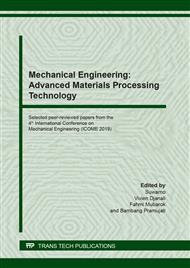[1]
D.C Smith and C Dennis, Dental Implants: Materials and Design Considerations, Int. J. Prosthodont 6 (1993) 106–117.
Google Scholar
[2]
G.R. Parr, L.K. Gardner, R.W. Toth, J. Prosthet., Titanium: The mystery metal of implant dentistry. Dental materials aspects, Dent. 54 (1985) 410–414.
DOI: 10.1016/0022-3913(85)90562-1
Google Scholar
[3]
T.D. Widodo, R. Raharjo, A. Wahyudiono, Effect of Low Temperature Steel Ball Peening on the Hardness of SS 316L, Key Engin. Mat, 791 (2018) 105– 110.
DOI: 10.4028/www.scientific.net/kem.791.105
Google Scholar
[4]
T.D. Widodo and K. Noda, Characterization of mechanical surface treated 304 stainless steel by electrochemical impedance spectroscopy, Sci. of Adv. Mat., 6 (2014) 2179-2184.
DOI: 10.1166/sam.2014.2063
Google Scholar
[5]
D. Krajcarz, D. Bankowski and P. Mlynarczyk, The Effect of Traverse Speed on Kerf Width in AWJ Cutting of Ceramic Tiles, Proc. Eng., 192 (2014z 469-473.
DOI: 10.1016/j.proeng.2017.06.081
Google Scholar
[6]
M. Hashish, A modeling study of metal cutting with abrasive waterjets, Mech. Eng. 106 (1984) 60–69.
Google Scholar
[7]
T. Zeng and J. Kim, An erosion model of polycrystalline ceramics in abrasive waterjet cutting, Wear 193 (1996) 207–217.
DOI: 10.1016/0043-1648(95)06721-3
Google Scholar
[8]
M. Hashish, Characteristics of surfaces machined with abrasive-waterjets, J. Eng. for Ind. 113 (1991) 29–37.
Google Scholar
[9]
S. Paul, AM Hoogstrate, C.A. van Luttervelt, H.J.J. Kals, Analytical and experimental modelling of the abrasive water jet cutting of ductile materials, J. Mat. Process. Tech. 73 (1998), p.189–199.
DOI: 10.1016/s0924-0136(97)00228-8
Google Scholar
[10]
P. R. Vundavilli, M.B. Parappagoudar, S.P. Kodali, S. Benguluri, Fuzzy logic-based expert system for prediction of depth of cut in abrasive water jet machining process., Know-Based Sys. 27 (2012) 456–464.
DOI: 10.1016/j.knosys.2011.10.002
Google Scholar
[11]
L.M. Hlavac, L.M. Hlavacova, L. Gembalova, L. Kal-icinsky, S. Fabian, J. Mestanek, Kmec, V. Madr, Investigation of Surface Roughness in Abrasive Water Jet Machining, J. Mat. Proc.Tech. 6 (2009) 6190–6195.
Google Scholar
[12]
J. Kechagias, G. Petropoulos, N. Vaxevanidis, Application of Taguchi design for quality characterization of abrasive water jet machining of TRIP sheet steels, Int. J. Adv. Manuf. Tech. 62 (2012) 635–643.
DOI: 10.1007/s00170-011-3815-3
Google Scholar
[13]
F. Boud, C. Carpenter, J. Folkes, P.H. Shipway, Abrasive waterjet cutting of a titanium alloy: The influence of abrasive morphology and mechanical properties on workpiece grit embedment and cut quality, J. Mat. Process. Tech. 210 (2010) 2197-2205.
DOI: 10.1016/j.jmatprotec.2010.08.006
Google Scholar
[14]
M.K. Babu and O.V.K. Chetty, A study on the use of single mesh size abrasives in abrasive waterjet machining, The Int. Jour. of Adv. Man. Tech., 29 (2006) 532-540.
DOI: 10.1007/s00170-005-2536-x
Google Scholar
[15]
A. Perec, Experimental research into alternative abrasive material for the abrasive water-jet cutting of titanium, The Int. J. Adv. Manuf. Tech., 97 (2018) 1529-1540.
DOI: 10.1007/s00170-018-1957-2
Google Scholar


